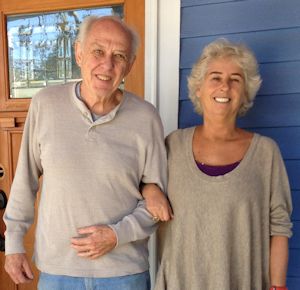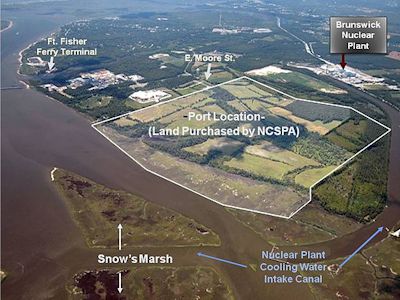SOUTHPORT — It’s been two years since a couple members of No Port Southport joined forces to form a separate group that strives to look at the bigger picture. Now they’re taking a big step toward reaching their goals, one of which is establishing a national seashore along the lower Cape Fear River.
Save the Cape has leased office space and officially opened its doors at 618 N. Howe St. in Southport on Monday. The historic building on the city’s main thoroughfare offers a front porch complete with a swing for the group’s leaders and members to congregate on pleasant days.
Supporter Spotlight
The founders and co-directors of the nonprofit group, Mike Rice and Toby Bronstein, hope this high-visibility location will allow them more frequent interaction with the public so they can promote the national seashore concept more widely and gain as much support as possible.
“It’s going to be challenging, but we’ve never shied away from a challenge,” Bronstein said.
 Mike Rice and Toby Bronstein. Photo: Judy Royal. |
The group is proposing the Cape Fear National Seashore, a protected area taking in Masonboro Island on the Atlantic Coast and all of the state parks and natural areas on the east side of the Cape Fear River south of Snow’s Cut to Bald Head Island. On the west side of the river, the northern limit would be the Town Creek swamp forest, and the reserved area would extend south to the sea at Caswell Beach. The reserved area would not include existing incorporated communities and the Military Ocean Terminal at Sunny Point.
The effort grew out of public opposition to the N.C. State Ports Authority’s N.C. International Terminal, a proposed mega-port in southeastern North Carolina for large container ships. The authority purchased more than 600 acres of old farming fields and woodlands stretching 4,000 feet along the Cape Fear River off East Moore Street near Southport for $30 million in 2006 for the new port. That idea, however, appears to be somewhat of a pipe dream after political opposition and funding snags have put the project on hold indefinitely. The land is now worth just under $13 million.
“It occurred to us that we should push for something really big: a national seashore,” Rice said.
Supporter Spotlight
The Save the Cape folks aren’t sure how the 600-acre tract would fit into the equation, but they think at least 200 acres could be a direct part of the protected area. As for the rest of the land, they are open to possibilities such allowing the local movie industry to use it as a backlot, having a national seashore headquarters there or even building an incubator for light industry.
But one thing is certain: They do not think it’s appropriate for heavy industry and will not rest until it’s rezoned “to something more benign,” Bronstein said. She and Rice admit most of their efforts thus far have been on the immediate goal of stopping the port with the national seashore idea still in conceptual stages.
“I think we’ll always be in stop-the-port mode until there’s disposition of that land,” Bronstein said. “We don’t believe it’s dead. We believe it’s simmering on the back burner. We don’t believe it’s as threatening today as it was a year ago, but we don’t believe it’s dead.”
“Right now there’s a virus that’s very much alive but dormant,” Rice added. “Until it’s snuffed out somehow, it’s a danger.”
They do, however, want to move forward with establishing a Cape Fear National Seashore as a parallel activity. They’ve spoken to Don Barger, senior director of the Southeast Regional Office of the National Parks Conservation Association, who has helped them identify the criteria for obtaining a feasibility study for national park status. They are:
- National, historical significance
- Suitability or uniqueness of the area
- Feasibility, or whether the physical integrity of the area remains intact and pristine
 Save the Cape hopes to include some portion of the land that the state bought for the proposed International Terminal in to new national park. |
Save the Cape leaders are looking into ways the public can acquire the land and are exploring possibilities, such as working with the N.C. Coastal Land Trust. The group acquires and protects of undeveloped land along the coast. It has, for instance, protected tracts on Masonboro and Lea islands. The group sometimes purchases lots in the areas identified for protection, but owners also occasionally donate them. Bronstein said she doesn’t think the latter is a possibility with the pricy parcels in question, but they plan to forge ahead.
“People have moved here from all over the country because of its unique charms,” she said.
North Carolina already has two of the country’s 10 national seashore areas: Cape Hatteras and Cape Lookout. Establishing such a designation literally takes an act of Congress, and the National Park Service requires many studies before that can happen.
Rice and Bronstein know they have a big task ahead of them, but that’s why they formed Save the Cape.
“You can’t fight something with nothing, and a positive approach might resonate better and give people an objective,” Rice said. “What Toby and I sense in this area is that it’s a very special place that is unique in many ways. There are creatures and plants here that live nowhere else.”
She and Rice stressed that they are not environmental extremists but rather concerned citizens seeking a more balanced approach to growth.
“We are not opposed to economic development,” Bronstein said. “We want economic development, but we want responsible economic development. We want to foster a respect and an appreciation for this unique area that we live in but not to the exclusion of job creation and economic development.”
They’ve modeled their organization after Save the Bay, an effort to protect Narragansett Bay in Rhode Island, established in 1970 as a result of a number of grassroots groups. Now, Save the Bay boasts dozens of employees, regular funding and political clout in the state.
“When a project comes along they get a seat at the table because they’re recognized as representing a lot of constituents and as someone who has to be reckoned with,” Rice said. “So that’s why we’re doing this. There should be an objective of changing people’s attitudes about what this area is all about.”








